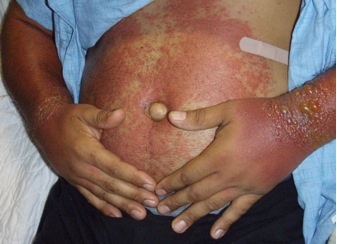Browse through our Journals...
Photo Allergic Dermatitis- Case Report
Tiburcio, Kwankam, Das
A 41y/o Hispanic male came to the Emergency Room complaining of a rash on his arms, torso, back, and on the face in a malar distribution. He denied any associated symptoms. The patient reported using Ivory soap and new downy fabric recenty. He hadn't used any new medications.
The patient had no significant past medical history.
During his stay in the ER, dermatology consults were provided. The patient was given a stat dose of prednisone 60mg. He was then admitted to the family medicine floor for further management
The patient’s vitals were found to be normal. Labs were drawn for ANA, anti-DNA antibody, antibody to Jo, ESR, CRP, blood and urine culture.
All labs within normal limit except for ANA borderline elevated with a titer of 1:40 and CRP 4.0

The patient stayed 4 days as an inpatient and was treated with prednisone 60mg PO daily and triamcinolone cream 1 application BID to affected areas.
During the patient’s stay it was recommended that patient have a skin biopsy. Pathology results of the skin sections showed a superficial perivascular infiltrate of lymphocytes with rare eosinophils and dermal mucin. The presence of occasional eosinophils would favour the diagnosis of hypersensitivity reaction including photo allergic dermatitis.
The patient was discharged in stable condition
F/U appointment with Rheumatology, PCP and dermatology as out pt
Discussion
Photosensitivity is a common form of inflammation that occurs in adults. The inflammation involves an abnormal cutaneous response after exposure to ultra violet rays of light (3). There is generally an equal distribution between males and females and can occur at any age. The eruption on the skin appears 1-2 days after exposure to sun and mostly in the areas that were exposed to the sun. Clinical experience and experimental research indicate that the cause is most probably multi factorial: contact allergenic, photo allergenic, phototoxic, immunologic, and metabolic factors are involved, but their precise roles in the origin of the extreme photosensitivity are still unclear (1). In many cases photosensitivity must be distinguished from other possibilities through patch testing which is a valuable tool to diagnose contact allergy (4). The most common lesion seen on physical exam in photosensitivity is pruritic, eczematous lesions. The lesions are symmetrically distributed in all the sun exposed areas. They are seen as papulonodular with a hemorrhagic crust, eczematous changes, lichenification, and mild scarring as a result of the puritus. Most cases are determined clinically. The photosensitivity reaction that occurs in patients is mostly due to UVB spectrum of sunlight and is mostly prevented by limiting the skin’s exposure to sunlight. The UVB sunburn response is the most common phototoxic reaction, and it appears to be non photodynamic in nature (2). In cases where patients already have a photosensitivity reaction, treatment is enhanced with a topical steroid cream as well as an orally ingested synthetic corticosteroid. In many patients with repeated photosensitivity reactions prophylactic ultraviolet therapy should be considered although it has varying degrees of effectiveness.
Dr Jose Tiburcio M.D.
Family Medicine Attendee, Bronx Lebanon Hospital Center
Dr Maureen Kwankam M.D.
Family Medicine Resident, Bronx Lebanon Hospital Center
Amitava Das, Student Doctor
Ross University School of Medicine
References
1) Vandermaesen J, Roelandts R, Degreef H. Light on the persistent light reaction—photosensitivity dermatitis—actinic reticuloid syndrome. Journal of the American Academy of Dermatology Vol.15, Part 1, October 1986, Pages 685-692
2) Epstein J. Phototoxicity and photoallergy in man. . Journal of the American Academy of Dermatology Vol.8, Issue 2, February 1983, Pages 141-147
3) Morison W. Photosensitivity. N Engl J Med 2004; 350:1111-1117
4) Nedorost S.T., Stevens S.R. Diagnosis and Treatment of Allergic Skin Disorders in the Elderly. Drugs & Aging Vol 18, Number 11, 2001, pp. 827-835
Copyright Priory Lodge Education Limited 2010
First published September 2010
Click
on these links to visit our Journals:
Psychiatry
On-Line
Dentistry On-Line | Vet
On-Line | Chest Medicine
On-Line
GP
On-Line | Pharmacy
On-Line | Anaesthesia
On-Line | Medicine
On-Line
Family Medical
Practice On-Line
Home • Journals • Search • Rules for Authors • Submit a Paper • Sponsor us
All pages in this site copyright ©Priory Lodge Education Ltd 1994-


